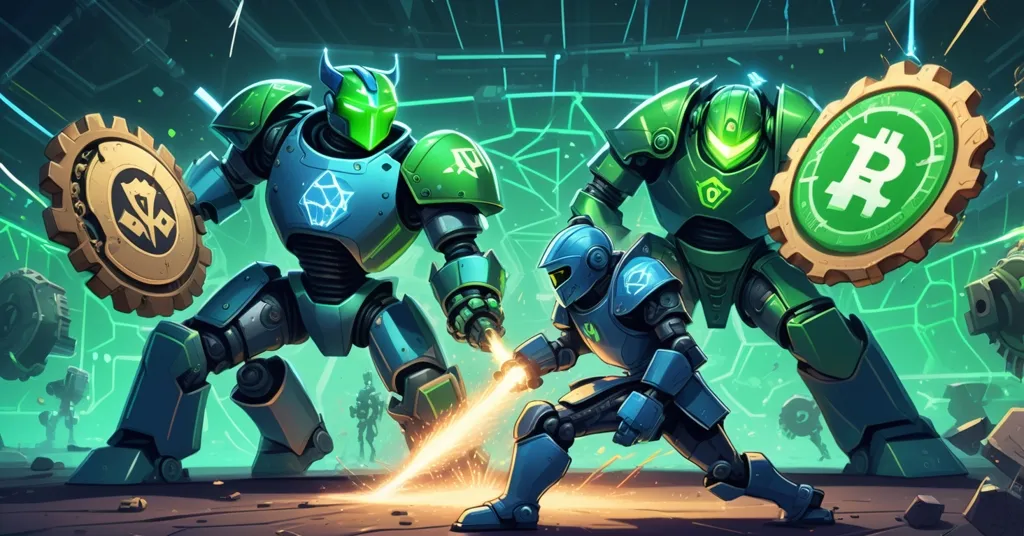Mutuum Finance (MUTM) vs. XRP: DeFi Newcomer Challenges Ripple for 2025 Dominance

Mutuum Finance (MUTM) vs. XRP: Can a New DeFi Project Outshine Ripple in 2025?
The crypto market is a relentless beast, spitting out new contenders and testing old warriors daily. Right now, Mutuum Finance (MUTM), a DeFi presale project promising sky-high returns, is turning heads, while XRP, Ripple’s embattled token, grapples with legal quicksand. Is MUTM’s decentralized lending and borrowing platform the next big thing, or just another overhyped gamble? And can XRP break free from regulatory hell to reclaim its former glory? We’re diving deep into this showdown with no patience for fluff or fairy tales—let’s get to the meat of it.
- MUTM Snapshot: Presale Phase 6 at $0.035, 95% sold, jumping to $0.040 soon; hyped for 200%–400% gains by late 2025 launch.
- XRP Struggle: Stuck at $2.350 resistance, weighed down by SEC lawsuit despite ETF buzz.
- Big Picture: Does a risky, untested DeFi upstart beat a proven but troubled altcoin for max ROI in 2025?
MUTM’s DeFi Vision: Bold Innovation or Empty Promise?
Mutuum Finance is carving a spot among potential top DeFi projects for 2025, built on the premise of revolutionizing lending and borrowing in the crypto space. It operates on a dual model: Peer-to-Contract (P2C), where users interact with smart contracts to supply liquidity or borrow from shared pools, and Peer-to-Peer (P2P), where individuals hash out custom loan terms directly. This isn’t just flashy jargon—there’s a safety mechanism at its core. Loans are overcollateralized, meaning if you borrow, you lock up more value in assets than you take out. Picture it like a pawn shop: you hand over a $1,000 watch to borrow $500, so if you don’t pay up, they’ve got collateral to cover the loss. It’s a buffer against defaults in a market where prices can nosedive overnight.
Breaking it down further, the Loan-to-Value (LTV) ratio—the percentage you can borrow against your collateral—ranges from a cautious 35%–55% for volatile assets like Bitcoin or speculative tokens, up to a generous 95% for stable ones like Ethereum (ETH) or USDT. Stable interest rates aim to keep repayments predictable, unlike some DeFi setups where rates can surge during market panic. Reserve factors, think of them as the platform’s emergency stash (set between 10% and 55% depending on asset risk), are there to absorb losses if things go south. An automated liquidator bot—basically a ruthless piece of code—swoops in to sell collateral if a borrower’s position becomes too risky, keeping the system solvent. These features sound slick, but they’re only as strong as the untested code behind them.
MUTM piles on extras to attract users: liquidity pools for passive earnings, mtTokens as staking rewards, debt tokens to track what’s owed, and a $1-pegged stablecoin to stabilize transactions in a volatile space. The V1 launch is scheduled for Q4 2025 on the Sepolia testnet, a proving ground for Ethereum-based projects where developers debug before risking real funds on the main network. Starting with support for ETH and USDT, MUTM’s presale is already in Phase 6 at $0.035 per token, with 95% sold and $18.9 million raised from over 18,100 investors. The next phase hikes the price 15% to $0.040, and some voices in the community are tossing around insane 200%–400% gain predictions by launch, with targets of $0.18 to $0.70 for a 4 billion token supply. Let’s be brutally honest: these numbers are often pure speculation, fueled by marketing hype rather than hard evidence. Presale projects have a track record of promising gold and delivering dust. For a deeper look into why some believe MUTM could offer massive ROI compared to XRP, the analysis speaks to its unique model.
To juice up interest, MUTM is dangling a $100,000 giveaway—$10,000 in tokens to ten winners—along with daily $500 rewards for the top leaderboard spot and bonuses for the top 50. It’s a classic hype tactic, but let’s not kid ourselves: shiny prizes don’t prove a project’s worth. Community engagement metrics like Discord activity or Twitter sentiment could offer a clearer picture of trust, but such data is scarce. Worse, there’s zero public info on the team behind MUTM or whether their smart contracts have been audited by reputable firms like Certik or OpenZeppelin. No audits, no transparency—this is a glaring red flag. If you’re eyeing this presale, proceed with extreme caution.
MUTM in the DeFi Jungle: Can It Compete?
Positioning itself among leading crypto lending platforms, MUTM faces giants like Aave and Compound, pioneers of overcollateralized lending. Aave adjusts interest rates dynamically based on supply and demand, while Compound leans on algorithmic precision—both have survived hacks and bear markets, proving their mettle. MUTM’s stable rates and high LTV for stable assets seem user-friendly, but they’re unproven. Will overcollateralization deter casual users who don’t want to lock up big chunks of capital just to borrow a fraction? And what about Ethereum’s notorious gas fees or scalability hiccups on a testnet launch? MUTM might target a real niche, but it’s entering a battlefield littered with the corpses of failed DeFi experiments. Survival isn’t guaranteed.
XRP’s War: Proven Utility Under Siege
Shifting focus to XRP, we’re dealing with a seasoned player tied to Ripple’s mission of overhauling cross-border payments. The XRP Ledger processes transactions in seconds for mere cents, a stark contrast to the sluggish, costly SWIFT system still propping up global banking. Steven McClurg, CEO of Canary Capital, nailed it when he said:
“XRP’s efficiency in enabling fast and low-cost global transfers via the XRP Ledger.”
That utility is drawing serious attention. Canary Capital’s XRP ETF, ticker XRPC, logged $58 million in trading volume on its debut day, and Franklin Templeton’s EZRP ETF adds to the institutional momentum. For the uninitiated, ETFs (exchange-traded funds) allow traditional investors to gain exposure to XRP without directly owning it, a gateway to wider adoption.
Yet, XRP’s price is locked in a tense standoff at $2.350 resistance. Failing to break through could trigger a retreat to support levels at $2.20 or even $2.150. The real drag is Ripple’s ongoing brawl with the U.S. Securities and Exchange Commission (SEC), kicked off in late 2020. The SEC argues XRP is a security—like a stock—since Ripple sold it to fund operations with investors expecting profits from the company’s work. Ripple counters that it’s a currency, akin to Bitcoin, outside SEC jurisdiction. Possible outcomes range from a minor fine to a crippling ruling against Ripple’s U.S. operations, or, in a dream scenario, legal clarity that XRP isn’t a security, potentially igniting a rally. Until resolution, uncertainty chills retail enthusiasm, even as institutions dip their toes via ETFs. Compared to MUTM’s presale freedom from regulatory glare, XRP’s fight feels like a slow bleed.
XRP’s Track Record and Uncertain Horizon
XRP has been through the wringer before. When the SEC lawsuit dropped in 2020, its price cratered over 60% in weeks, only to claw back ground as snippets of hope emerged. Its payment use case—already leveraged by companies like MoneyGram for remittances—sets it apart from many altcoins, though mass adoption remains elusive. If the SEC saga wraps favorably by 2025, XRP price predictions could flip bullish, bolstered by ETF traction signaling Wall Street’s long-term bets. But don’t count your chickens—institutional interest doesn’t always spark retail pumps, and Ripple’s centralized grip on a massive XRP supply clashes with the decentralization we hold sacred in this space. It’s a double-edged sword: proven utility, questionable ethos.
Through Bitcoin’s Lens: Do Either Measure Up?
As champions of Bitcoin’s supremacy, we view BTC as the untouchable benchmark—peerless in decentralization, security, and its role as digital gold. MUTM and XRP operate in separate arenas, but neither rivals Bitcoin’s purity. MUTM’s DeFi angle tackles lending and borrowing, a gap Bitcoin doesn’t fill, yet it’s tethered to Ethereum’s ecosystem, which pales against BTC’s battle-tested network. XRP’s payment efficiency could theoretically pair with Bitcoin’s store-of-value narrative, but Ripple’s centralized control raises red flags. Both hint at decentralization’s promise to upend traditional finance, yet they’re distant cousins to Bitcoin’s hardcore resilience. If they deliver, they might earn a seat at the table; if not, they’re just distractions.
Risk Showdown: MUTM’s Wild Card vs. XRP’s Burden
Why does MUTM get buzz as a 2025 ROI champ over XRP? It’s about raw potential versus stagnation. As a presale project, MUTM dangles the kind of explosive upside XRP, a more mature token, can’t offer. Staking rewards, stablecoin mechanics, and lending utility craft a sexy story of disruption, while XRP’s tale is bogged down by legal sludge. But let’s not fall for the siren song. Presale ventures like MUTM are a goddamn minefield—untested tech, shadowy teams, and pie-in-the-sky price targets often end in rug pulls or total flops. Overcollateralized loans sound like a safety net, but if the smart contracts are buggy or unaudited (as we suspect), they’re worthless. Investors need to grill this project harder than a steak on a barbecue before risking a penny.
XRP’s risks, while more transparent, bite just as hard. The SEC limbo could drag on, sapping momentum, and even ETF hype might not lift prices if retail trust stays shattered. But there’s a flip side: legal clarity could unleash a beast, and XRP’s established use case offers a stability MUTM can only dream of. It’s a clash of raw gamble versus slow grind—MUTM is a startup rig that might overheat, while XRP is a dented but running machine. Pick your poison.
Key Questions and Takeaways for Crypto Investors
To cut through the noise of this DeFi versus altcoin face-off, here are the critical questions on every investor’s mind, answered straight with a focus on navigating the crypto frontier:
- What is Mutuum Finance (MUTM) offering to the table?
MUTM is a DeFi platform for lending and borrowing, blending Peer-to-Contract and Peer-to-Peer models with overcollateralized loans, staking rewards via mtTokens, liquidity pools, and a $1-pegged stablecoin. It’s in presale at $0.035 with a testnet launch set for Q4 2025 on Ethereum’s Sepolia network. - Why might MUTM outstrip XRP in 2025 returns?
MUTM’s early-stage presale pricing and utility-focused design hint at massive short-term growth for risk-seekers, while XRP’s potential is throttled by regulatory woes and slower upside as a veteran asset. - What are the screaming red flags with MUTM’s hype?
With no live product until late 2025, MUTM risks unproven tech, scam potential, and team obscurity. No info on smart contract audits or developer credentials, plus speculative price targets, demands hardcore due diligence. - Can XRP rebound despite its legal quagmire?
Yes—ETF traction from players like Canary Capital and a favorable SEC outcome could spark a comeback. But near-term gains depend on smashing $2.350 resistance, and Ripple’s centralization remains a sticking point. - Should you dive into MUTM’s presale now?
Only if you’ve got an iron stomach for risk. Its speculative nature, delayed launch, and unverified fundamentals mean you’re betting on a vision, not reality. Vet the team and security setup ruthlessly first. - How do MUTM and XRP stack against Bitcoin’s ideals?
MUTM’s DeFi push for financial access fills a niche Bitcoin ignores, but Ethereum’s framework lacks BTC’s purity. XRP’s payment speed could mesh with Bitcoin’s value store, yet Ripple’s control undercuts true decentralization.
Crypto is a high-stakes arena where daring pays off, but stupidity gets slaughtered. MUTM’s blueprint for decentralized lending resonates with our passion for financial disruption and freedom, yet it’s a long shot riddled with pitfalls. XRP carries a legacy of utility but stumbles under legal weight. Whether you’re a Bitcoin purist or an altcoin adventurer, this choice hinges on your tolerance for chaos versus caution. One rule stands firm: no space for bullshit or blind bets. Research like your wallet depends on it—because it does. This revolution doesn’t wait, and it sure as hell doesn’t spare the reckless.



